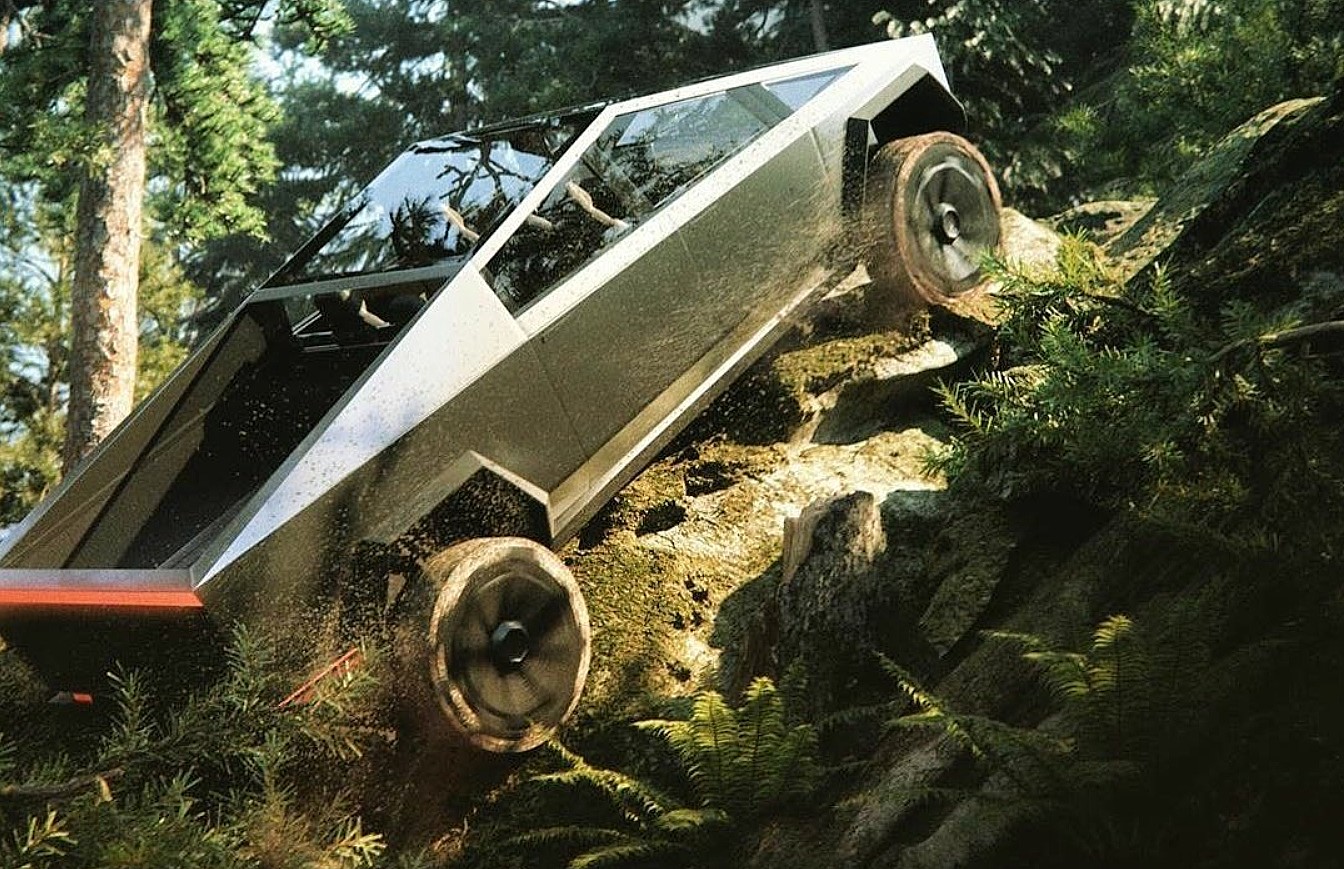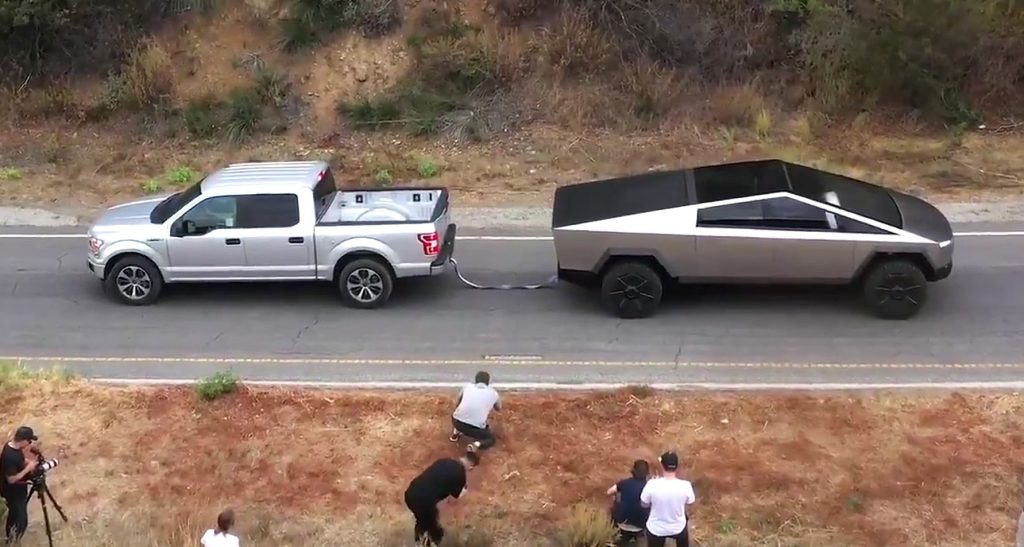

News
Tesla’s Giga Texas completely solves the Cybertruck’s ‘Cowboy Problem’
Yesterday, Elon Musk posted a cryptic tweet asking the Twitterverse about the possibility of Tesla establishing a Giga Texas facility. The response was overwhelmingly positive, despite some Tesla supporters questioning the rationale behind the notion of investing in a state that has been practically hostile to the company. Yet Tesla’s upcoming lineup of vehicles, particularly its Cybertruck, the addition of Giga Texas to the company’s growing list of factories may very well be a godsend. It could, for one, address the Cybertruck’s “Cowboy Problem” in Texas.
Texas is a large market for pickup trucks. Pickups are so popular in the Lone Star state that the automotive auctioneering firm Mecum did not even bother including sedans and other cars in its auction in Houston last year. Texas accounts for about one of every six pickups sold in the United States. Considering that trucks are among the most popular vehicles in the country, this number is very substantial. This is a goldmine that disruptive all-electric companies like Tesla can tap into, provided their vehicles are embraced by consumers.
In a recent article, author David Freedman noted that real truck buyers primarily worship a vehicle’s specs and utility when considering their next purchase. This is the reason why workhorses such as the Ford F-150 have become such a juggernaut in the United States auto market, and in Texas in particular. Former GM executive Tony Posawatz, who was behind the Chevy Volt, highlighted this in a statement. “Truck buyers are more sophisticated than car buyers in what they’re looking for. They look at their truck as a tool,” he said.

Tesla and its Cybertruck team appear to be fully aware of this, as evidenced by the vehicle’s features and specs, many of which seemed to have been included following CEO Elon Musk’s brainstorming session with his followers on Twitter. From hauling capacity to sheer unadulterated power, the Cybertruck has it all. The vehicle even offers a range of over 500 miles per charge in its sub-$70,000 configuration, something that is yet to be matched by other upcoming EV truck makers like Rivian. The Cybertruck is designed to take an immense amount of punishment without flinching as well, thanks to its stainless steel exoskeleton.
Its controversial looks aside, the Cybertruck objectively has the features and specs that can make it a massive disruptor in the EV segment. Yet there are psychological barriers that work against the vehicle’s favor, and one of them may very well be Tesla’s reputation as a California-bred, Silicon Valley-based company that makes sleek, futuristic cars. Simply put, Tesla does not have the reputation of a car maker that can produce tough vehicles for work. Ford, GM, and other veteran automakers do, and they could be counting on this for their own upcoming electric trucks.
Gabriel Smart of Planet Ford in Houston, which primarily sells trucks, describes the automaker’s pitch for its F-150. “When someone comes in for a Ford truck, it’s because that’s what their buddy drives, it’s what their dad drives, it’s what their granddad drives. So that’s what they want to drive, too,” he said. Tesla, then, has a challenge ahead of it. The company would not only have to buck the stereotypes of electric vehicles with the Cybertruck; it would also have to prove to dedicated truck buyers that its all-electric pickup is a serious alternative to tried and tested vehicles such as the F-150.

One of the ways that the company can do this is to simply make the Cybertruck as the de facto electric vehicle of Texas by producing the truck right in the state itself. If Giga Texas does pan out, and if the facility ends up producing vehicles like the Cybertruck, it would be very difficult for Texas’ regulators and truck buyers to not support the vehicle. The Cybertruck is already compelling enough with its specs, features, and price alone. Add the fact that it is built using American labor at the heart of pickup country, and the vehicle may very well become the symbol of the US’ next-generation of trucking. This, ultimately, solves any possible “Cowboy Problem” Tesla may have with its all-electric pickup, and it may open up the state to more of the company’s vehicles as well.
Elon Musk noted during the fourth-quarter earnings call that the demand for the Cybertruck has been impressive so far, with the company getting enough orders to correspond to several years’ worth of production. “I have never seen actually such a level of demand as this — we’ve never seen anything like it basically. I think we will make as many as we can sell for many years. So — as many — we’ll sell as many as we can make, it’s going to be pretty nuts,” Musk said. And this is all before the Cybertruck can even tap into the heart of the US’ pickup market.
The Cybertruck is expected to enter the market next year. Tesla plans to start with the tri-motor AWD and dual motor AWD. The $39,990 single motor RWD Cybertruck, which undercuts competitors such as the Rivian R1T, is expected to start production in late 2022.

Elon Musk
Elon Musk and Tesla AI Director share insights after empty driver seat Robotaxi rides
The executives’ unoccupied tests hint at the rapid progress of Tesla’s unsupervised Robotaxi efforts.

Tesla CEO Elon Musk and AI Director Ashok Elluswamy celebrated Christmas Eve by sharing personal experiences with Robotaxi vehicles that had no safety monitor or occupant in the driver’s seat. Musk described the system’s “perfect driving” around Austin, while Elluswamy posted video from the back seat, calling it “an amazing experience.”
The executives’ unoccupied tests hint at the rapid progress of Tesla’s unsupervised Robotaxi efforts.
Elon and Ashok’s firsthand Robotaxi insights
Prior to Musk and the Tesla AI Director’s posts, sightings of unmanned Teslas navigating public roads were widely shared on social media. One such vehicle was spotted in Austin, Texas, which Elon Musk acknowleged by stating that “Testing is underway with no occupants in the car.”
Based on his Christmas Eve post, Musk seemed to have tested an unmanned Tesla himself. “A Tesla with no safety monitor in the car and me sitting in the passenger seat took me all around Austin on Sunday with perfect driving,” Musk wrote in his post.
Elluswamy responded with a 2-minute video showing himself in the rear of an unmanned Tesla. The video featured the vehicle’s empty front seats, as well as its smooth handling through real-world traffic. He captioned his video with the words, “It’s an amazing experience!”
Towards Unsupervised operations
During an xAI Hackathon earlier this month, Elon Musk mentioned that Tesla owed be removing Safety Monitors from its Robotaxis in Austin in just three weeks. “Unsupervised is pretty much solved at this point. So there will be Tesla Robotaxis operating in Austin with no one in them. Not even anyone in the passenger seat in about three weeks,” he said. Musk echoed similar estimates at the 2025 Annual Shareholder Meeting and the Q3 2025 earnings call.
Considering the insights that were posted Musk and Elluswamy, it does appear that Tesla is working hard towards operating its Robotaxis with no safety monitors. This is quite impressive considering that the service was launched just earlier this year.
Elon Musk
Starlink passes 9 million active customers just weeks after hitting 8 million
The milestone highlights the accelerating growth of Starlink, which has now been adding over 20,000 new users per day.

SpaceX’s Starlink satellite internet service has continued its rapid global expansion, surpassing 9 million active customers just weeks after crossing the 8 million mark.
The milestone highlights the accelerating growth of Starlink, which has now been adding over 20,000 new users per day.
9 million customers
In a post on X, SpaceX stated that Starlink now serves over 9 million active users across 155 countries, territories, and markets. The company reached 8 million customers in early November, meaning it added roughly 1 million subscribers in under seven weeks, or about 21,275 new users on average per day.
“Starlink is connecting more than 9M active customers with high-speed internet across 155 countries, territories, and many other markets,” Starlink wrote in a post on its official X account. SpaceX President Gwynne Shotwell also celebrated the milestone on X. “A huge thank you to all of our customers and congrats to the Starlink team for such an incredible product,” she wrote.
That growth rate reflects both rising demand for broadband in underserved regions and Starlink’s expanding satellite constellation, which now includes more than 9,000 low-Earth-orbit satellites designed to deliver high-speed, low-latency internet worldwide.
Starlink’s momentum
Starlink’s momentum has been building up. SpaceX reported 4.6 million Starlink customers in December 2024, followed by 7 million by August 2025, and 8 million customers in November. Independent data also suggests Starlink usage is rising sharply, with Cloudflare reporting that global web traffic from Starlink users more than doubled in 2025, as noted in an Insider report.
Starlink’s momentum is increasingly tied to SpaceX’s broader financial outlook. Elon Musk has said the satellite network is “by far” the company’s largest revenue driver, and reports suggest SpaceX may be positioning itself for an initial public offering as soon as next year, with valuations estimated as high as $1.5 trillion. Musk has also suggested in the past that Starlink could have its own IPO in the future.
News
NVIDIA Director of Robotics: Tesla FSD v14 is the first AI to pass the “Physical Turing Test”
After testing FSD v14, Fan stated that his experience with FSD felt magical at first, but it soon started to feel like a routine.

NVIDIA Director of Robotics Jim Fan has praised Tesla’s Full Self-Driving (Supervised) v14 as the first AI to pass what he described as a “Physical Turing Test.”
After testing FSD v14, Fan stated that his experience with FSD felt magical at first, but it soon started to feel like a routine. And just like smartphones today, removing it now would “actively hurt.”
Jim Fan’s hands-on FSD v14 impressions
Fan, a leading researcher in embodied AI who is currently solving Physical AI at NVIDIA and spearheading the company’s Project GR00T initiative, noted that he actually was late to the Tesla game. He was, however, one of the first to try out FSD v14.
“I was very late to own a Tesla but among the earliest to try out FSD v14. It’s perhaps the first time I experience an AI that passes the Physical Turing Test: after a long day at work, you press a button, lay back, and couldn’t tell if a neural net or a human drove you home,” Fan wrote in a post on X.
Fan added: “Despite knowing exactly how robot learning works, I still find it magical watching the steering wheel turn by itself. First it feels surreal, next it becomes routine. Then, like the smartphone, taking it away actively hurts. This is how humanity gets rewired and glued to god-like technologies.”
The Physical Turing Test
The original Turing Test was conceived by Alan Turing in 1950, and it was aimed at determining if a machine could exhibit behavior that is equivalent to or indistinguishable from a human. By focusing on text-based conversations, the original Turing Test set a high bar for natural language processing and machine learning.
This test has been passed by today’s large language models. However, the capability to converse in a humanlike manner is a completely different challenge from performing real-world problem-solving or physical interactions. Thus, Fan introduced the Physical Turing Test, which challenges AI systems to demonstrate intelligence through physical actions.
Based on Fan’s comments, Tesla has demonstrated these intelligent physical actions with FSD v14. Elon Musk agreed with the NVIDIA executive, stating in a post on X that with FSD v14, “you can sense the sentience maturing.” Musk also praised Tesla AI, calling it the best “real-world AI” today.








